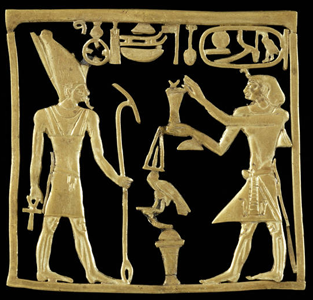

In Ancient Egypt yellow (khenet, kenit) represented that which was eternal and indestructible, and was closely associated with gold (nebu or nebw) and the sun. Gold was thought to be the substance which formed the skin of the gods and numerous statues of the gods were either made of gold or covered with gold leaf. The skin of the god was often painted gold in two dimensional images.

The pharaoh’s sarcophagus was made of gold, as he was thought to become a god on his death. The pharaoh would be adorned with a variety of gold amulets and jewellery during mummification and often wore a golden mask. A golden “Shen” amulet was placed over the breast of the mummy to give the deceased the protection of Ra and ensure that he or she would live as long as the sun shone.

In the undisturbed burial of Tutankhamun archaeologists discovered a beautiful solid gold and Lapis Lazuli funeral mask, as well as a 300 pound solid gold coffin and an assortment of beautiful gold or gold plated funeral goods. The Twenty-first Dynasty pharaoh, Psusennes I (Third Intermediate Period), was buried with a solid silver coffin and a beautiful solid gold mask. Gold was often paired with blue in Egyptian royal jewellery. The iconic Pharonic “Nemes” head scarf was composed of blue (often lapiz lazuli) and gold stripes and numerous pieces of gold and lapis jewellery have been recovered from royal burials.




Egyptian women were generally depicted with yellow skin, as were Asiatics and Libyans. During the Old Kingdom powerful officials were often depicted with yellow skin indicating that they (like women) spent more time indoors away from the suns rays. Depictions of groups of people often alternate yellow and brown skin to differentiate the members of the group, and younger people are more often depicted with lighter coloured skin.
The ancient Egyptians also made yellow pigments such as yellow ochre (an ore of iron) and massicot (an oxide of lead). By the New Kingdom they also used orpiment, a sulphide of arsenic. Yellow was sometimes interchangeable with white, which represented purity.
Copyright J Hill 2010